Haiti’s Preserve of Caribbean Biodiversity: La Navase
La Navase Island Is Ours
Haiti Chery
Ile de la Navase lies 25 miles (40 km) southwest of the town of Jeremie, Haiti, and 37 miles (60 km) off the Cap des Irois on the western tip of the island of Hispaniola. The 2-square mile (5.2 square km) island is claimed by Haiti, Cuba, and the United States, and it has even been used by Great Britain.
The issue of sovereignty first arose in 1858 and then again in 1998.
Under the Guano Act, the U.S. Congress had declared in 1856 that any uninhabited island containing guano, which are mineable quantities of bird droppings, would be made a U.S. protectorate. After Captain Peter Duncan discovered in 1856 that the guano on La Navase was a high-quality fertilizer — a mixture of nitrate and phosphate that also got used from 1865 to 1898 as a powder in armament — he recommended that the island be taken under U.S. tutelage.
The only problem with this recommendation was that several early Haitian Constitutions, starting in 1801, had noted the islands adjacent to Haiti as being an integral part of the country. According to the Constitution of Haiti, a Haitian territory is deemed to be Haitian even if it is uninhabited. The Constitution of 1874 is more precise on this point, because the second paragraph of Article 2 refers to La Navase by name.
Returning to the quarrel of 1858. It began with a communication dated March 10 from the British and French consuls stating that U.S. citizens had stepped foot on La Navase, declared it a U.S. territory, and planted their flag on it.
Around the same time, some British citizens argued that the island fell between the Haitian and Jamaican coasts and wondered to whom it belonged. The British government responded that La Navase was clearly a Haitian possession.
Haiti’s ruler then, Faustin Soulouque, responded vigorously to the U.S. threat by dispatching two warships in April 1858 with instructions to expel the settlers by force. The operators of the Navase Phosphate Company were informed of the Haitian objections to the claim by U.S. authorities. The intervention unfortunately came to nothing because of Soulouque’s overthrow by Geffrard.
In 1917, the U.S. installed its coastguard on the island.
In 1989, the Haitian military government dispatched a team of radio amateurs there by army helicopter. They planted the Haitian flag into the ground and an inscription of Haitian sovereignty. For several hours, they issued radio messages from Radio Free Navase. On September 8, an advocacy group for La Navase wrote to U.S. authorities that the GPS system there obviates a need for U.S. coastguards. According to Familypedia:
“On August 29, 1996 the U.S. Coastguard dismantled the lighthouse light, and on January 16, 1997 the coastguard transferred La Navase to the U.S. Department of Interior. By Secretary’s Order No. 3205 of January 16, 1997, the Department of the Interior Department assumed control of the island and placed it under its Office of Insular Affairs. La Navase was initially grouped with the ‘U.S. Miscellaneous Caribbean Islands; it is now grouped with ‘U.S. Minor Outlying Islands’ along with other islands claimed by the U.S. under the Guano Islands Act.”
The territorial conflict re-emerged strongly in 1998, and La Navase remains a point of contention between Haiti and the U.S. The arrogance of Ambassador Timothy Camey did not help matters any when he said that the 1857 law put La Navase under U.S. sovereignty because the island was uninhabited and rich in fertilizer.
Notwithstanding the geographical position and Constitutional Law that undoubtedly make La Navase a Haitian territory, it is regrettable that maps of Haiti have not traditionally noted La Navase.
Familypedia informs us again that:
“By Secretary Order No. 3210 of December 3, 1999, the United States Fish and Wildlife Service assumed administrative responsibility for ‘Navassa,’ which became a National Wildlife Refuge Overlay, also known as ‘Navassa Island National Wildlife Refuge.’ Access to the island requires permission from the U.S. Fish and Wildlife Office in Boquerón, Puerto Rico.”
The issue now is not about guano, which is no longer used, but about the incredible biodiversity of the island and its fantastic biological wealth.
A 1998 scientific expedition led by the Center for Marine Conservation in Washington D.C. described La Navase as
“A unique preserve of Caribbean biodiversity.”
and reported that the island’s land and offshore ecosystems had survived the twentieth century
“virtually untouched.”
Indeed La Navase enjoys an exceptional seabed with varieties of fish, scorpions, and spiders unknown elsewhere. Scientists from the 1998 and 1999 U.S. Quest expeditions reported:
- Discovery of 90 species of spiders, including 25 previously unknown to science.
- Identification of 227 species of fish including five new species.
- Species of plants unique to the island, such as the palm Pseudopheonix Sarget saonae, and two endemic species of lizard, Cyclura nigerrima and Leicocephlus erimitus, thought to have disappeared.
According to the Journal of Biological Conservation,
“The shallow reefs of Navassa (<23m) have high live coral cover (20–26.1%), a high degree of architectural complexity (rugosity index range 1.4–1.9), and moderate abundance of the keystone grazing urchin, Diadema antillarum, at all sites (mean 2.9±0.9 per 30 m2). Thus, Navassa reefs appear to be trophically intact with fish populations relatively ‘unexploited,’ presenting a conservation challenge and a research opportunity”
Interestingly, although Haitians do not live on the island, they have fished sustainably along its coasts for centuries. The Journal of Biological Conservation grudgingly notes that:
“Despite its remoteness, an unregulated, artisanal fishery (primarily using traps and hook and line) carried out by Haitians is the primary mode of human impact on Navassa reefs.
“Even so, reef fish communities exhibit high density (range 97–140 fish per 60 m2) and retain representation by large snapper, grouper and herbivores, which are mostly lacking in nearby Caribbean locations with high fishing pressure.
“The regulation and conservation of the fishery will be difficult, due to the international nature of the situation. However, given the apparently small impact that artisanal fisheries have yet had on its reef communities, Navassa presents a possibly unique opportunity to study the ecological functioning of a relatively trophically intact Caribbean reef, and represents a strong imperative for conservation, monitoring, and research.”
Indeed. But these scientists missed a valuable opportunity to go one step further and recommend returning the island to Haiti and learning a thing or two from Haiti’s fishermen about wildlife conservation. DC
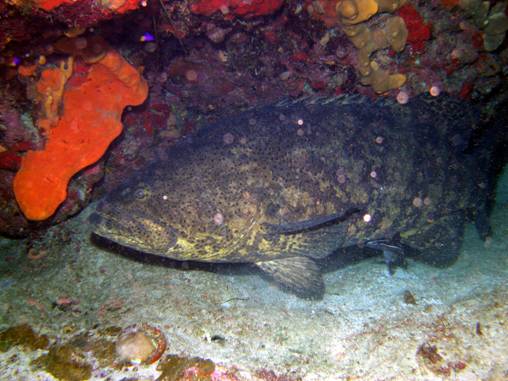
Over 300 fish species have been identified in La Navase waters, many of them new. This five-foot goliath grouper, Epinephelus itajara, found in 2006 was unexpected because there appeared to be no nearby habitat for juveniles.
Background: Alliance Haiti | Familypedia | coRIS

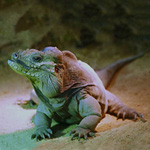
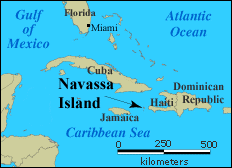
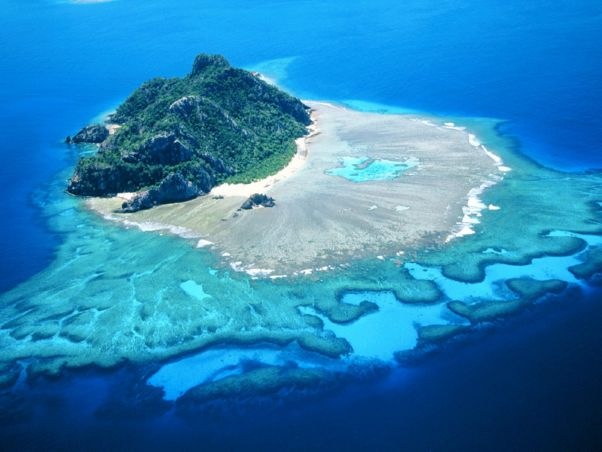
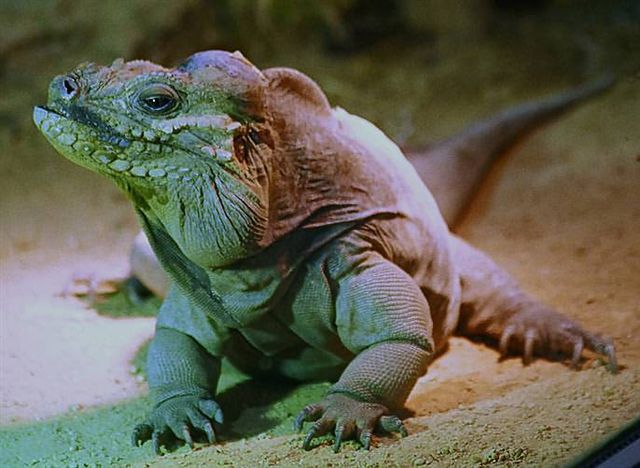
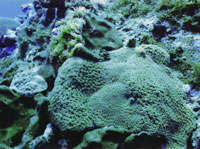
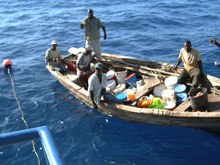


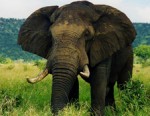
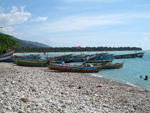
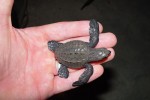
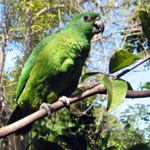
Cette île est le territoire incontesté d’Haïti. Apparemment, elle est de nouveau colonisée par un mafieux italien Ezio Caglione, ancien consul honoraire de la Somalie en Italie, est celui qui a orchestré l’envoi des déchets en Haïti et qui s’est proclamé le prince de la Navase. Pour moi, ce ne serait pas étonnant que les Etats-Unis aient pu la vendre à ce mafieux, connaissant l’arrogance des américains qui considèrent les Caraïbes comme leur arrière-cour. Il faudrait que les dirigeants haïtiens puissent se pencher sur cette question, vu l’immense richesse en biodiversité qu’elle contient!
Biodiversity my foot, talk to me about rare earth minerals. How you gonna do conservation on lands that don’t belong to you in the 1st place?
Yes, the land does belong to Haiti and “Ile La Navase” is noted as being Haitian territory in Haitian constitutions. And conservation is often not the things you do, but the things you don’t do, like fish the coast from huge fishing boats or wander off with animals and plants. Westerners talk a good game about conservation, as if they could set an example after rerouting all their streams, drying up many of their rivers and wiping out nearly all their major predators and their forests.
bonjou mwen byen kontan jwen yon bel imaj konsa eoi se la kay mwen ayiti li ye mwen ta renmen jwen yon lekol lot bo a la navase pou mwen al sitote moun yo jwen de twa bagay ki te ka bon pou yo mesi mwen ap tan repnos nou sou email mwen an bye
ki sa pou mwen fe pou’m ke achte yon moso te la ba a? paske mwen menm ak fanmim nou vle retounen lakay nou pi vit ke posib. mwen se yon teknisyen nan domenn electrisite ak refrijerasyon,epi mwen fe plonbri tou. mwen genyen konesans sou zefe elvaj pwason ak zannimo epi madanm mwen se yon nes. nou ta ranmen abite non yon lye kote moun konpann lavi moun k’ap travay pou ede peyi’m soti nan touman. tout eseye mwen eseye deja nan potopwens, se lanmo ki toujou menase’m. sim te ka rankontre ak majistra zonn sa mwen ta va kontan. mwen selman genyen 30 l’anne sou tet mwen e mwen fatige travay pou moun k’ap kraze peyi’m.
Unissons nous par tous les moyens pour dejouer le plan de ces voleurs qui veulent nous ravir une partie de notre patrimoine. La navase est Haitienne et non Americaine.